100% absorption over a small area makes little practical difference. It is easy enough to make 1 ft^3 active absorbers that are effectively 100% sound absorbers below 100 Hz or so but they are rarely used because they don't do enough to be worthwhile. If you have a loud booming axial mode bouncing between the front and back walls which you want to absorb either passively or actively (without using the information in the music signal) then it has to cover most of one or both walls or else most of it will remain to continue booming.
You are using an out of date browser. It may not display this or other websites correctly.
You should upgrade or use an alternative browser.
You should upgrade or use an alternative browser.
Speaker/Room Measurement Witchcraftery
- Thread starter S-Man
- Start date
ToTo Man
the band not the dog
https://www.acousticfields.com/product/acda-12-activated-carbon-diaphragmatic-absorber/
"100% absorption at 50 Hz., 63% at 40 Hz". Unless it can be custom tuned to peak at the exact frequency required (I have GIK Scopus custom "T35"s for my 35 Hz mode) then I won't spring for it. Peaking at the wrong frequency will actually make bass sound weirder IMO. It's really important to measure, then tune the traps accordingly, IME.
PS:
It's MUCH harder to absorb 35Hz than 50Hz! I also have two user-tunable fridge-freezer sized HH resonators tuned to 35Hz, and they only halved the long resonance. These HH resonators absorb very narrow band, and the T35s more wide band - but both peak at the mode frequency 35Hz. After all this, I've still got a mode problem but it's mitigated enough for me.
100% absorption over a small area makes little practical difference. It is easy enough to make 1 ft^3 active absorbers that are effectively 100% sound absorbers below 100 Hz or so but they are rarely used because they don't do enough to be worthwhile. If you have a loud booming axial mode bouncing between the front and back walls which you want to absorb either passively or actively (without using the information in the music signal) then it has to cover most of one or both walls or else most of it will remain to continue booming.
My room is 4.14m x 3.78m x 3.25m so my axial modes are 41Hz, 45Hz and 53Hz. Based on the above advice the most obvious passive solution would be to cover my sidewalls with T41 tuned membrane traps, my front and back walls with T45 tuned membrane traps, and my ceiling with 53Hz tuned membrane traps.
This however would presumably leave very little space for broadband absorption to reduce decay times above 100Hz, which was a major problem in my room before I installed GIK Corner Tri Traps. I chose Tri Traps because according to GIK data it has very even absorption, although it is ultimately limited in its absorption potency compared products like Soffits.
GIK broadband absorption data:
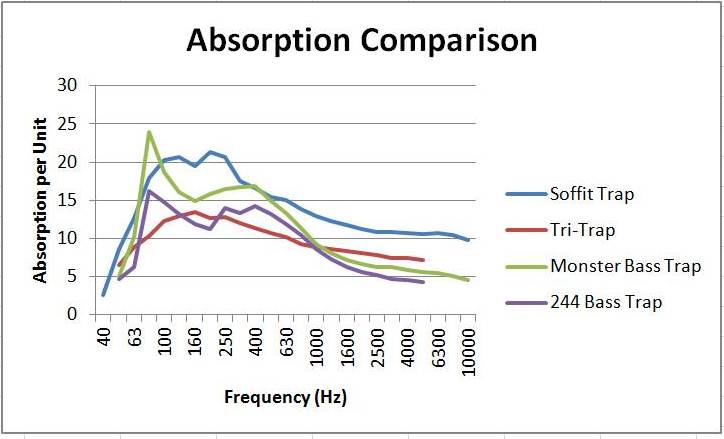
GIK tuned membrane data:
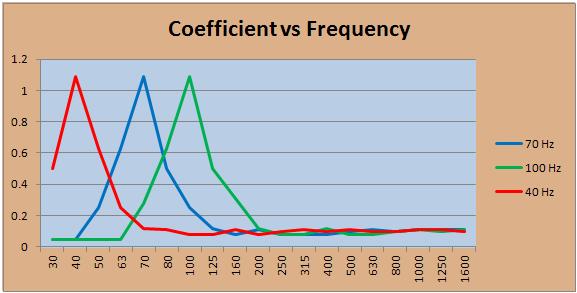
My own data:
These are measurements I took of my room in 2013, comparing no treatments vs first reflection treatment only vs first reflection treatment and 40% of my corners treated vs first reflection treatment and 80% of my corners treated:
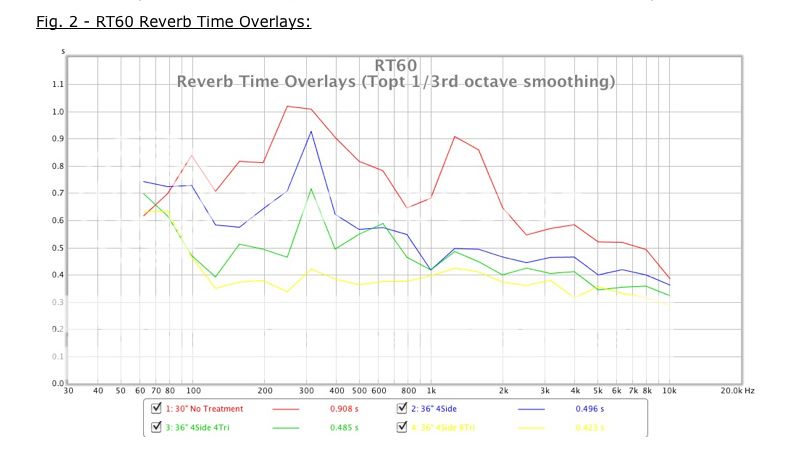
I then DIY'd some additional corner traps to fill the remaining 20% spaces, with further improvements made to decay times:

100% absorption over a small area makes little practical difference. It is easy enough to make 1 ft^3 active absorbers that are effectively 100% sound absorbers below 100 Hz or so but they are rarely used because they don't do enough to be worthwhile. If you have a loud booming axial mode bouncing between the front and back walls which you want to absorb either passively or actively (without using the information in the music signal) then it has to cover most of one or both walls or else most of it will remain to continue booming.
Here’s a video of one of Northward Acoustics studio walls absorbing .. and I think there’s stuff going on behind that too..
https://m.facebook.com/story.php?story_fbid=10153505200543372&id=106287663371&_rdr
Fascinating stuff.
March Audio
Trade: March Audio
And a very likely explanation.Agreed, I am taking it as speculation.
What is your opinion as to how a speaker can manifest “one note bass"
How do you personally define one note bass?
March Audio
Trade: March Audio
Oh that ramp was a cock up in the dsp settings, gone now. As mentioned it's a 10dB slope from 20hz to 24 kHz.That's a stunning looking room, @March Audio. Can I ask the reason for the steep rise in low frequency output below 30Hz, is it a personal preference?
Hopefully when I get a bigger listening room I'll use lots more passive treatments than I'm currently able to accommodate (at the moment I have all four corners stacked bottom to top with GIK TriTraps and have four GIK 244 absorbers at first reflection points on sidewalls).
I dream of having a room large enough to be able to lower the ceiling and bring each wall in and stuff the cavities with rockwool, and then use thinner absorption panels and diffusers in the visible area of the room for a more streamlined look.
PS - I'd be interested to hear your opinion on Acoustic Fields "Activated Carbon Diaphragmatic Absorption" product? (www.acousticfields.com/product-category/sound-absorption). According to the maker it is much more effective at reducing modal frequencies than Tuned Membrane absorbers such as the GIK T40 etc. The downside is it is very heavy and expensive (though they do sell a DIY version, - basically they supply the carbon and you build the enclosure). However if the maker's claims are to be believed, it offers significantly better low frequency absorption than any other comparable passive room treatment.
I will take a look at those acoustic fields products later.
March Audio
Trade: March Audio
Again it was the 4 subs that really did the trick.
ToTo Man
the band not the dog
So are the four ASW608s responsible for extending your bass response to 20Hz and below or do you have a larger fifth subwoofer? I imagine the ASW608s have to work quite hard with lots of EQ. Then again I've never tried four subs so don't know what sort of efficiency gain you get compared to just having two...Again it was the 4 subs that really did the trick.
---------------------
EDIT 1 - Just downloaded the manual for the ASW608:
Drive unit: 1x 200mm (8 in) paper/Kevlar® cone long-throw
Frequency range: -6dB at 23Hz and 25/140Hz adjustable (EQ at A)
Frequency response: ±3dB 32Hz - 40/140Hz adjustable (EQ at A)
Bass extension: -6dB at 23Hz (position A) -6dB at 28Hz (position B) -6dB at 36Hz (position C)
That's pretty decent extension for a compact unit, though I imagine distortion will come into play at higher SPLs?
-------------------
Edit 2 - Just stumbled upon your post on ASR, - interesting stuff...
The only advice I recall giving is that distributed subwoofers are the only practical add-on approach in the home that I am aware of that works well below 80-100 Hz. What you suggest is not aligned with this and although you might be able to get it to do something close to what you want the cost is likely to be high in terms of the quality of the living space.My room is 4.14m x 3.78m x 3.25m so my axial modes are 41Hz, 45Hz and 53Hz. Based on the above advice the most obvious passive solution would be to cover my sidewalls with T41 tuned membrane traps, my front and back walls with T45 tuned membrane traps, and my ceiling with 53Hz tuned membrane traps.
You mention improving decay times as if lowering them is good. Did they sound like improvements to you when you did them? What is your ideal target? Are you listening to stereo or surround sound? Do you lean more towards clean studio created music or towards reverberant concert halls? Did treating the first reflections sound like an improvement? Was this achieved for all frequencies or just the higher frequencies?
What you have been doing with your room looks interesting but a bit patchy. What kept you from tackling the low frequencies?
March Audio
Trade: March Audio
So are the four ASW608s responsible for extending your bass response to 20Hz and below or do you have a larger fifth subwoofer? I imagine the ASW608s have to work quite hard with lots of EQ. Then again I've never tried four subs so don't know what sort of efficiency gain you get compared to just having two...
---------------------
EDIT 1 - Just downloaded the manual for the ASW608:
Drive unit: 1x 200mm (8 in) paper/Kevlar® cone long-throw
Frequency range: -6dB at 23Hz and 25/140Hz adjustable (EQ at A)
Frequency response: ±3dB 32Hz - 40/140Hz adjustable (EQ at A)
Bass extension: -6dB at 23Hz (position A) -6dB at 28Hz (position B) -6dB at 36Hz (position C)
That's pretty decent extension for a compact unit, though I imagine distortion will come into play at higher SPLs?
-------------------
Edit 2 - Just stumbled upon your post on ASR, - interesting stuff...
Yes they are surprising. Thing to remember is that using them in corner positions yields a large boundary gain, up to 9dB (each). With 4 (+6dB) you end up not driving them that hard.
Yes distortion increases but remember you aren't that sensitive to it at very low frequencies
Last edited:
S-Man
StrivingON
And a very likely explanation.
What is your opinion as to how a speaker can manifest “one note bass"
How do you personally define one note bass?
No, it's pure speculation. You have never heard my system and you are trusting my novice measurements, which were made with no attempt to make them look nice. It's easy to make them look nicer, but I chose not to.
I define one note bass as being when it's hard to determine the pitch of the note. IME this is caused by poor alignment of the fundamental and the harmonics, in the time domain.
In the end, it's all down to personal preference. My system sounds quite a bit better than Kii3s to me, in my room. And Kii3s are very good (when warmed up).
My room is also my living room, I don't want it to look like a studio or a man cave or whatever, so I accept that it influences the sound.
Purité Audio
Trade: Purite Audio
How would you have made them look nicer, by actually time aligning the drivers and improving the step response ?
Or by treating the bass peaks?
Keith
Or by treating the bass peaks?
Keith
ToTo Man
the band not the dog
It is likely to be costly financially as well, as each 600mm x 600mm membrane trap is £150 + VAT!The only advice I recall giving is that distributed subwoofers are the only practical add-on approach in the home that I am aware of that works well below 80-100 Hz. What you suggest is not aligned with this and although you might be able to get it to do something close to what you want the cost is likely to be high in terms of the quality of the living space.
You mention improving decay times as if lowering them is good. Did they sound like improvements to you when you did them? What is your ideal target? Are you listening to stereo or surround sound? Do you lean more towards clean studio created music or towards reverberant concert halls? Did treating the first reflections sound like an improvement? Was this achieved for all frequencies or just the higher frequencies?
My listening is 75% music / 25% TV. I don't have a surround sound setup, only a 2.2 setup with no form of DSP other than a few basic parametric EQ filters I apply in Audirvana+ to reduce the axial modes at my listening position for music playback.
My goal by adding the additional DIY chunks to extend the coverage of the GIK TriTraps from floor to ceiling was to try to make more impression on decay times below 125Hz. In this respect the result has been positive (though not hugely so). However it has also had the effect of lowering decay times across the rest of the frequency spectrum from an average of 350ms to an average of 300ms. I was not intending this result, but I don't think it's been harmful. Would I enjoy music more with a decay time of 400ms instead of 300ms? Perhaps, perhaps not? I mainly listen to music that's been recorded in a studio environment.
I do find it interesting that I have achieved such a significant reduction in RT60 with such a modest amount of room treatment compared to what many others use. Apart from a carpet, rug and single fabric-clad reclining chair, there are no other absorbing surfaces in my listening room! Maybe I'd have been better with Corner Traps faced with reflective wooden scatter plates to retain more liveliness? (GIK didn't make these in 2013 so there wasn't a choice then, unfortunately).
Lack of knowledge / fear of the unknown?!What you have been doing with your room looks interesting but a bit patchy. What kept you from tackling the low frequencies?
When I purchased my passive room treatment in 2013 I was a complete novice to room acoustic issues and was lead to believe that the products I was purchasing would be effective in reducing amplitude peaks and nulls and decay times all the way down to 50Hz!
I have since purchased two XXLS400 subwoofers, hoping that they would both extend and smooth out my low frequency response. They've done at great job at the former but not so good at the latter, I suspect this is because I'm running my main speakers full range and have set the subs to crossover at 30Hz @ 24dB/oct which is just below where my mains roll off and is below my lowest room mode. I'm using the subs in a conventional stereo configuration sited beside the main speakers. No digital DSP or time alignment, just basic software-based parametric EQ which is applied globally to the mains and the subs.
I would consider adding two more subs if it would help smooth out the response, but I expect this will require a more complicated setup with DSP boxes etc? I'd like to keep things as simple as possible. How would I implement this without messing too much with the D/A conversion process and, ultimately, the signal that's fed to my main speakers?
I do have Dirac Live 2-channel installed on my Mac but haven't used it since switching to my latest speakers more than a year ago. Would this be of use or do I need additional hardware/software that's able to EQ and time align each sub individually? And what about my main speakers, can I keep them running full-range or will I need to high-pass them?
PS - Sorry for so many questions!
Purité Audio
Trade: Purite Audio
Sorry we have determined that your speakers aren’t time aligned and that you have large bass untreated bass peaks in your room, then you gave your definition of ‘one note bass’ as ‘poor alignment of the fundamental and harmonics in the time domain’.Kei3th, are you and March in cahoots?
Just read the thread. I answered this as far back as post #11 (and probably several times since).
Unlike some, I don't like to repeat myself endlessly
Presumably that’s why you suffer from one note bass?
Keith
camverton
pfm Member
Yes, but if you were to buy certain speakers from a certain dealer all your “problems” would be solved, and your graphs would be a delight to behold.... allegedly!Yes, it's a pile of shite.
Happy now?
March Audio
Trade: March Audio
There is nothing wrong with your measurements, you did a good job. They do exactly what I would expect for a room with those dimensions and I have measured and listened to many similar rooms, including my own.No, it's pure speculation. You have never heard my system and you are trusting my novice measurements, which were made with no attempt to make them look nice. It's easy to make them look nicer, but I chose not to.
I define one note bass as being when it's hard to determine the pitch of the note. IME this is caused by poor alignment of the fundamental and the harmonics, in the time domain.
In the end, it's all down to personal preference. My system sounds quite a bit better than Kii3s to me, in my room. And Kii3s are very good (when warmed up).
My room is also my living room, I don't want it to look like a studio or a man cave or whatever, so I accept that it influences the sound.
OK, problem with that definition is that Im afraid its your speakers that have the poor... correction, no its not poor per-se, its actually very typical..... time alignment issues, something which the Kii doesnt. So you need to look for a different explanation
Your time alignment - sharp tweeter impulse followed b y wider mid/bass, followed by wider sub. So a low frequency fundamental having harmonics that play through the mid will be about a 1.5 mS early and through the tweeter 3 ms early.
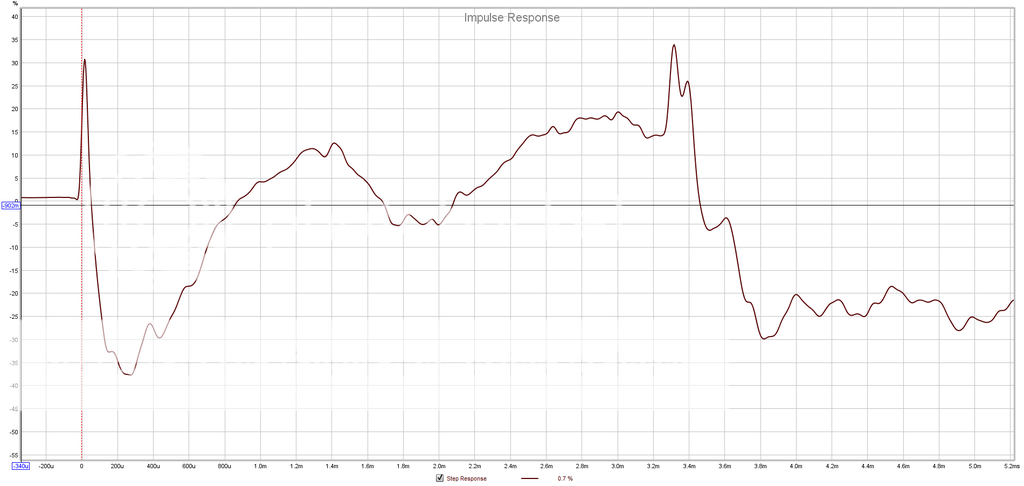
From stereophile, Kii impulse.
I captured the Three's impulse response and calculated the step response. The result is shown in fig.1—other than a very slight rise and dip at the 92ms mark, the Kii Three has a superbly time-coincident wavefront launch. Its step response is almost a perfect right-triangle shape, indicating that the outputs of the drive-units all arrive at the microphone at the same time.
Read more at https://www.stereophile.com/content/kii-audio-three-loudspeaker-measurements#s8iG21ZpKYJ782VW.99
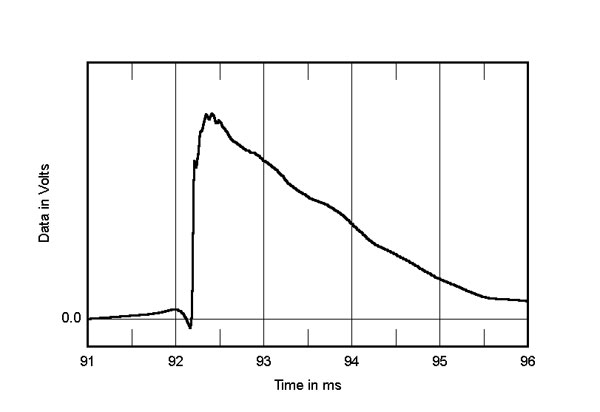
Im not knocking what sound you like and I certainly wouldnt have a living room looking like my theatre room, but you dont necessarily have to. DSP can help correct things like the impulse response and modes.
Last edited:
March Audio
Trade: March Audio
Well I think the point is more that, whether you believe it or not, better measurements do lead to better sound.Yes, but if you were to buy certain speakers from a certain dealer all your “problems” would be solved, and your graphs would be a delight to behold.... allegedly!
March Audio
Trade: March Audio
No, we just both have extensive experience of measuring room acoustics. I have worked professionally in noise/acoustic measurement and modelling, plus I have designed speakers.Kei3th, are you and March in cahoots?
Just read the thread. I answered this as far back as post #11 (and probably several times since).
Unlike some, I don't like to repeat myself endlessly
With the greatest of respect, the things you think are happening are not. The analysis of the data here is not contentious, and its not meant to belittle or any such thing. Just use the info and measurements to gain a greater understanding of whats really going on. You can then choose to act on it in the most appropriate manner for your circumstances......or not...but presumably you took the measurements for a reason?
Last edited:
It would be interesting to know where that notion came from and if one or two suggested at the time this wouldn't be the case and that studio/home theatre levels of room treatment are not necessarily ideal for stereo in the home. On the other hand, just as some like stereo over headphones and others dislike it to the extent of being mildly distressed, preference plays a significant role which doesn't seem to get discussed much by audiophiles in terms of targets and so for some studio/home theatre levels of room treatment may well be ideal.When I purchased my passive room treatment in 2013 I was a complete novice to room acoustic issues and was lead to believe that the products I was purchasing would be effective in reducing amplitude peaks and nulls and decay times all the way down to 50Hz!
As I think I mentioned before this looks like a major waste to me. One of the advantages of using subwoofers is removing the large low frequency motion of the woofer/midwoofer cone in the main speakers which modulates the midrange output. I think someone posted K&H measurements showing this earlier in the thread. Why don't you want this for your setup?I have since purchased two XXLS400 subwoofers, hoping that they would both extend and smooth out my low frequency response. They've done at great job at the former but not so good at the latter, I suspect this is because I'm running my main speakers full range and have set the subs to crossover at 30Hz @ 24dB/oct which is just below where my mains roll off and is below my lowest room mode. I'm using the subs in a conventional stereo configuration sited beside the main speakers. No digital DSP or time alignment, just basic software-based parametric EQ which is applied globally to the mains and the subs.
I would consider adding two more subs if it would help smooth out the response, but I expect this will require a more complicated setup with DSP boxes etc? I'd like to keep things as simple as possible. How would I implement this without messing too much with the D/A conversion process and, ultimately, the signal that's fed to my main speakers?
If the main speakers have enough cone area to produce clean output down to 35 Hz without relying on the output being boosted by room boom then you are in a good place to start working towards high fidelity music reproduction. Boundary reinforcement is fine but boom is not. This tends to mean something like a 12" woofer or 2 x 8" woofers and no interest in sounds below 35 Hz. If you are interested in sounds below 35 Hz then a big sub in a corner and a reasonably sealed room will deliver it. What you then need to do is to distribute some subs around the room to primarily absorb the room boom plus add a bit of output at frequencies where the main speakers are poorly located within the room to do so. It is likely to be impractical to do this in any other way than with a microphone, separate DSP for each subwoofer and computer software to sort it all out. If you don't want to do a nice clean "proper job" but something less effective then success is going to depend on what aspects of (technical) sound quality you are prepared to give up in order to gain the other things you value. This is likely to be a fairly large exercise well beyond a forum post or two.
I don't know what algorithms are used by this commercial software. A quick look at their how it works page did not seem to tell me how it worked. You may or may not be able to instruct it to maximise the output from the mains. If so, you should then be able to compare it with a more conventional arrangement and judge what value you place on a cleaner midrange.I do have Dirac Live 2-channel installed on my Mac but haven't used it since switching to my latest speakers more than a year ago. Would this be of use or do I need additional hardware/software that's able to EQ and time align each sub individually? And what about my main speakers, can I keep them running full-range or will I need to high-pass them?
What is required is separate DSP for each subwoofer. 4 is a good number in a reasonably symmetrical room like yours but my new modestly sized inconveniently arranged L shaped room with intrusions is possibly going to end up with more like 8 when I finally get round to sorting it out later in the year. If you are opting for multiple subs for music quality rather than the sound of exploding planets then they don't need to be huge. Around 10" cones perhaps although I will be going with 8" because of the number and size of the room. In the unlikely event of becoming interested in the sound of exploding planets a large 15" ported unit in a corner could be added.

